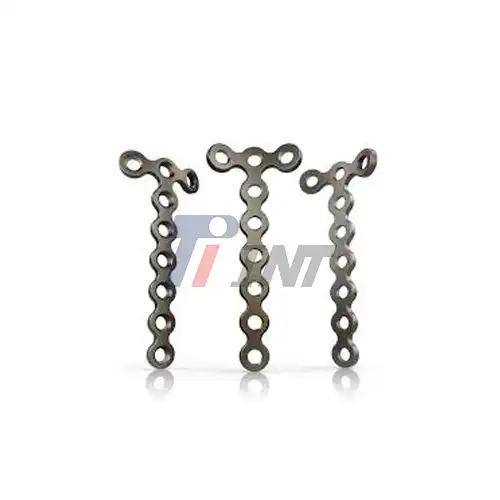The Science Behind Titanium Plates in Wrist Fracture Treatment
Understanding Wrist Fractures and Their Challenges
Wrist fractures are common injuries that can significantly impact a person's quality of life. These fractures often occur due to falls, sports injuries, or accidents. The complex anatomy of the wrist, consisting of multiple small bones and intricate ligaments, makes treating these fractures particularly challenging. Traditional methods of treatment, such as casting or external fixation, may not always provide optimal results, especially in cases of complex or unstable fractures.
The Advent of Titanium Plates in Orthopedic Surgery
The introduction of titanium plates, including the titanium plate for broken wrist, has marked a significant advancement in the field of orthopedic surgery. These plates are designed to provide internal fixation, offering a more stable and precise method of aligning fractured bones. The use of titanium in medical implants dates back several decades, with continuous improvements in design and manufacturing techniques enhancing their efficacy.
Biomechanical Advantages of Titanium Plates
Titanium plates for broken wrists offer several biomechanical advantages over other materials. Their high strength-to-weight ratio allows for robust support without adding excessive bulk. This property is crucial in the wrist, where space is limited, and minimizing implant size is essential for patient comfort and function. Additionally, the elastic modulus of titanium is closer to that of bone compared to other metals, reducing the risk of stress shielding and promoting better bone healing.
Key Benefits of Titanium Plates for Wrist Fracture Healing
Enhanced Stability and Fracture Alignment
One of the primary benefits of using titanium plates for wrist fractures is the enhanced stability they provide. These plates are designed to hold the fractured bones in precise alignment, which is crucial for proper healing. The rigidity of titanium ensures that the fracture remains stable even under stress, allowing patients to start rehabilitation earlier and potentially reducing the overall recovery time.
Biocompatibility and Reduced Risk of Complications
Titanium's excellent biocompatibility is a significant advantage in orthopedic implants, including the titanium plate for broken wrist. The material is well-tolerated by the human body, minimizing the risk of adverse reactions or rejection. This biocompatibility ensures a lower incidence of complications such as infection or inflammatory responses, which can delay healing or necessitate additional surgeries. The corrosion-resistant nature of titanium further contributes to its long-term safety and efficacy as an implant material.
Customization and Versatility in Treatment
Modern titanium plates for wrist fractures are highly customizable, allowing surgeons to tailor the treatment to each patient's specific needs. These plates come in various shapes and sizes, accommodating different fracture patterns and wrist anatomies. The ability to contour and shape titanium plates during surgery ensures a perfect fit, optimizing fracture reduction and stability. This versatility makes titanium plates suitable for a wide range of wrist fractures, from simple breaks to complex, multi-fragment injuries.
Long-Term Outcomes and Patient Benefits
Accelerated Healing and Rehabilitation
The use of titanium plates in wrist fracture treatment often leads to accelerated healing and rehabilitation. The stable fixation provided by these plates allows for early mobilization of the wrist, which is crucial for preventing stiffness and maintaining range of motion. Patients can typically begin gentle exercises sooner, promoting better circulation and faster healing of soft tissues around the fracture site. This early rehabilitation can significantly improve long-term outcomes, including better wrist function and reduced risk of chronic pain or stiffness.
Durability and Long-Term Performance
Titanium plates are known for their exceptional durability and long-term performance, making the titanium plate for broken wrist an ideal solution. The fatigue resistance of titanium ensures that the plates maintain their strength and integrity over time, even under repeated stress. This durability is particularly important in wrist fractures, where the implant may be subjected to constant motion and load-bearing. The long-lasting nature of titanium plates often eliminates the need for implant removal surgeries, reducing the overall burden on patients and healthcare systems.
Improved Quality of Life and Functional Outcomes
Perhaps the most significant benefit of titanium plates for wrist fractures is the improved quality of life and functional outcomes for patients. The precise alignment and stable fixation provided by these plates often result in better restoration of wrist anatomy and function. Patients typically experience less pain, improved grip strength, and a greater range of motion compared to traditional treatment methods. This translates to a quicker return to daily activities, work, and sports, significantly enhancing overall patient satisfaction and quality of life.
Conclusion
Titanium plates for broken wrists represent a significant advancement in the treatment of wrist fractures. Their unique properties, including biocompatibility, strength, and customizability, make the titanium plate for broken wrist an excellent choice for promoting optimal healing and functional recovery. As medical technology continues to evolve, the use of titanium implants in orthopedic surgery is likely to expand further, offering even more refined solutions for complex fractures.
For patients facing wrist fractures, the option of titanium plate fixation provides a promising path to faster recovery and better long-term outcomes. To learn more about innovative titanium solutions for orthopedic applications, contact Baoji INT Medical Titanium Co., Ltd. at export@tiint.com.










 2025-06-23 16:04:15
2025-06-23 16:04:15


_1753429726760.webp)
_1752644608314.webp)
_1751956503238.webp)
_1750668839491.webp)



